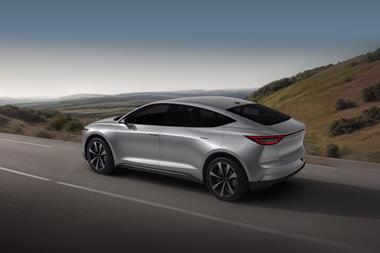While its growth has so far failed to match that of China, global automotive OEMs and suppliers are still eager to strengthen their production footprints in the country
The political uncertainty which has affected India in recent times has resulted in an uncertain environment for the automotive industry to plan for this potentially enormous market. It had been widely expected that India would mirror China’s rapid economic expansion before long, but lately there has been either only modest growth, or indeed some decline, in automotive market volumes. Total sales in India fell in 2013 for the first time since 2002, including a decline in passenger car sales of 11% to just over 1.8m units, although utility vehicle sales rose to over 500,000 units. Large commercial vehicles (CVs) fell by 29% to 215,000 units.
The government responded to declining car sales by cutting excise duty, and this gave a modest boost to demand from mid-2014 onwards: in May, June and July sales rose, with the July figure of 138,000 units representing a 5% increase on the July 2013 volume.
Although the growth potential in the Indian automotive market has long been recognised, reflected by already significant investment in the country, the recent uncertainty has led to something of a slowdown in investment. Yet with the relaxation of excise duties currently boosting sales, there is an expectation that investment funds will soon flow more freely. Certainly, the political environment of the moment is seen as being more stable than for several years. Much of the recent investment and expansion in the Indian automotive industry has come from international companies, as reviewed below.
Despite current difficulties, observers of the Indian auto industry remain positive about its prospects. Ernst & Young India, for example, still expects economic growth rates of 7-8% per annum, which should in turn translate into strong per capita income growth and lead to greater car ownership ratios. By 2020, E&Y India believes that a domestic market of around 6-6.5m vehicles is realistic, with as many as 2m units more built for export. Ford expects 7m units a year from India by 2020, while the Indian operation of ZF, the transmissions specialist, is more bullish, predicting up to 9m vehicles a year made in India.
A focus on small cars & SUV/MPV crossovers
The main growth in the Indian market is expected to occur in two segments: entry-level sedans and small or compact SUVs, MPVs and crossovers. Unsurprisingly, these are the very vehicle types which the global manufacturers are – or soon will be – making in the country. Renault’s Duster (sold as the Dacia Duster in Europe) and Ford EcoSport are typical of the small SUVs which are proving popular in India; in the MPV segment, there is Honda Mobilio, the Toyota Innova and Nissan Evalia. In the small car segment, the Datsun Go and Hyundai i20 have been especially well received; and at Hyundai, such has been Indian and regional demand for the i20 that production for Europe has switched to Turkey, enabling the Indian plant to focus on serving the domestic and regional markets.

The current market leader, Maruti Suzuki (effectively a domestic brand, despite Suzuki’s control of the model line-up), has a market share of over 40%. This will surely fall as the international players discussed below expand in India. And this will be despite Maruti Suzuki’s expectations of growing sales from 1.1m to 1.5m units per year in India, while also increasing exports from 120,000 units to as many as 300,000.
Mahindra & Mahindra and Tata (owners of Jaguar Land Rover) are the other major domestic players. This review focuses, however, on the investment and growth plans of the international vehicle companies who are now beginning to look at India far more seriously than before.
The Americans: Ford, GM & Fiat Chrysler
Ford has a substantial operation in India, and despite the group’s financial problems in Europe and South America, the company continues to invest in the country. It is nearing the end of a $1 billion investment in its new Sanand plant near Ahmedabad. This will be the company’s second plant, after its long-established Chennai factory. The two plants will have a combined capacity of 610,000 engines and 440,000 vehicles. Sanand will actually be one of Ford’s most automated plants in Asia, with a level of 95% in the bodyshop (versus 30% for other Ford plants in the region). Supporting this new plant will be a network of key suppliers which have established plants nearby.
GM has a somewhat smaller presence in India than Ford. It has two plants and a total capacity of 250,000 units (although some reports have put the figure at more like 280,000); the factory at Talegaon can make close to 160,000 units per year, while Halol in Gujarat is smaller, at 110,000 units. Both plants received investment during 2012-13, raising their capacity from 140,000 and 85,000 units per annum respectively.
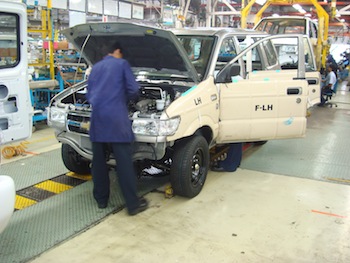
At Talegaon, GM will add production of the Beat (an export version of the Spark) in early 2015; this vehicle will be sold in Africa, and if it is successful in other export markets, this could mean further expansion at the Indian factory. The Beat will also be exported to Latin America, with Chile receiving the first consignment from India before the end of 2014.
Fiat Chrysler has now also recognised the potential of India. Although Fiat has been active in India for a number of years, this has been for entry-level vehicles, mostly versions of the Palio – the brand’s key model for emerging markets such as South America, India and Russia. Now that the newly merged Fiat Chrysler is in full flow, a fresh approach to India has been adopted; a wider range of models will be made and sold in the country.
In late October 2014, reports emerged that Fiat Chrysler would make C-segment SUVs under the Jeep name, as part of project 556, from late 2016. This vehicle is expected to be produced on a new line at Fiat India’s Ranjangaon factory, near Pune; this programme is for the Patriot/Compass replacement. The same factory is also expected to produce vehicles under programme 326 which will replace the Punto and Linea cars, again within the next two to three years.
The Europeans: VW & Renault
Volkswagen, which originally entered the Indian market with its Skoda brand in 2001, is poised for a new phase of expansion in India. The company currently operates two manufacturing facilities in the country, at Pune and Aurangabad. The Pune plant has received total investment to date of close to $800m and now has a capacity of 130,000 units per year; further investment of $250m is planned over the next five to six years. This will involve, amongst other things, raising capacity to 200,000 units per annum.
VW also intends to increase localisation of components for the vehicles it makes in India from the current level of around two-thirds to as much as 90%. This will, of course, require substantial investment by suppliers, and is likely to involve several European suppliers to the VW group being encouraged to move to India to support this strategy. Furthermore, VW will add diesel engine production at Pune by the end of 2014; capacity to make around 100,000 1.5-litre TDI engines on a three-shift system is being installed in a plant which already has its own press, body, paint and assembly facilities.
It is also worth noting that, having made mostly Skodas and small VWs, currently the Polo and Vento in both left- and right-hand drive format, the company has now added production of the Audi A3 sedan to Aurangabad; production of this model started in August on a single-shift basis, with the initial plan being to make 14,000 units per annum. This will open up what VW regards as the new compact luxury sedan segment in the country. The main Skoda model now made in India is the Rapid sedan, along with a small number of Superbs made from CKD kits. Long-term production plans are still being developed but are expected to include SUVs in the near future.
Renault’s involvement in India centres on a joint venture plant with Nissan in Chennai. Like many other car factories in the country, this has been the subject of recent investment to expand capacity. During 2013, it rose in two stages from 380,000 to 480,000 units per year, primarily to accommodate production of the new Datsun range, which Nissan is also producing in Russia, Indonesia and a number of other emerging markets. Datsun has been revived to exploit what Nissan sees as a booming market for low-cost entry vehicles; Nissan did not want to devalue its existing brand by producing lower-cost versions of existing vehicles under its own name.
Moreover, the Chennai factory is significant as the first truly joint manufacturing operation between Nissan and Renault. For example, the plant has made the Nissan Micra and Sunny under the same roof as the Renault Duster (the Dacia name has not been used in India). Some Micras are currently exported to Europe, although in 2016 production of the next Micra will switch back to Europe; the new model will be made by Renault in France, where there is much unused capacity.
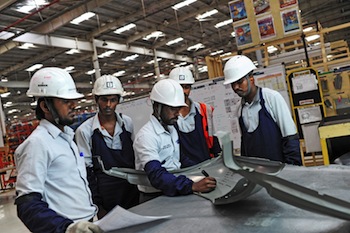
Once Chennai is producing the Datsun range at full line rates by 2015, total Renault-Nissan investment in Chennai will have exceeded $1 billion. The site also has the space to build a second plant with a further 400,000-unit capacity per year, should demand justify it. The first Datsun, a GO (a five-door hatchback), rolled off the Chennai assembly line in February 2014, with other versions including an MPV expected to follow over the next few years.
The current facility also produces engines for the Renault, Nissan and Datsun ranges, the decision to localise engine production having been taken to overcome the 60% duty on imported engines, as well as to save on shipping costs and to avoid the risk of currency fluctuations. Although the engines were designed and developed in Japan and France, the engines made in India will have close to 100% local content. Nissan claimed in 2013 that its vehicles already had local content of nearly 90%, apart from the engines.
It is worth noting in passing that Renault’s French competitor, PSA, is not currently active in India, having exited the country in 1997; there have been rumours of its return, but in August 2014 the company denied plans for a partnership with Mahindra. PSA has enough problems in Europe, and better opportunities to exploit in China.
Along with investments from the volume car manufacturers, the premium brands are by no means ignoring India. BMW/Mini, Mercedes and Jaguar Land Rover (which is of course owned by Tata of India) all possess developing, if still modest, presences in the country.
BMW decided to manufacture the Mini Countryman and Mini One at its Chennai plant, making India the first location outside the UK to make Minis, albeit from CKD kits. The Mini models are made alongside most of the BMW range, which is also assembled from kits, ie the 1-Series, 3-Series, 5-Series, 7-Series, X1 and X3. Capacity at Chennai is small, though it was raised in late 2013 from 11,000 to 14,000 units per year. A second facility is also under construction in India and should be in operation in the near future.
In a move which will help to increase the local content of Indian-assembled BMWs, the company is understood to be planning to source engines in India from Force Motors, which also supplies engines to Mercedes’ Indian operation. Force will open a new plant to supply BMW in Tamil Nadu, and will be subject to an investment of Rs 100 crores ($16m).
Mercedes, which has been operating a 10,000-unit assembly plant, essentially a CKD operation, to make the S-class and M-class, said in June 2014 that it would build a second assembly plant in the country. This would double Mercedes capacity in India, although details of which models are to be made there have yet to be confirmed.
Jaguar Land Rover assembles Jaguar XF and XJ and Land Rover Freelanders from CKD kits. Full manufacturing will follow in the near future. It has also been reported that the outgoing Freelander assembly line and tooling could be shipped from the UK to India to allow Tata to make a modified version of the Freelander for sale under the Tata name. However, this has not been officially confirmed.
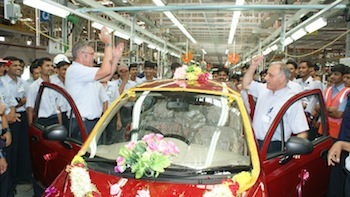
In addition to Nissan (present in combination with Renault), most of the other Japanese vehicle companies are also strongly represented in India; as noted at the outset, Suzuki is effectively a domestic player through its stake in Maruti.
Honda has two car plants in the country and is in the process of planning a third, in Gujarat. Its existing plants are in Greater Noida, Uttar Pradesh, and Tapukara, Rajasthan. This latter plant, which is a full manufacturing facility, currently produces 60,000 units per annum on a single-shift basis but will soon move to a two-shift system. This site has plenty of room to expand, whereas the factory at Greater Noida is constrained. Tapukara has been making the Amaze small car and added the City in September, after it was transferred from Greater Noida.
The key reason behind the decision to build a third plant is Honda’s wish to use India as a major export hub for the region. Honda, which has spoken of itself as the leading manufacturer of premium cars in India, has now moved into the MPV segment with the seven-seater Mobilio. This is one of the vehicles at the heart of Honda India’s export strategy, with South Africa the first market to receive export models during Q4 2014. In addition to exporting cars, Honda plans to use its plant in Rajasthan as an export base for manual transmissions; these will be supplied to the OEM's factories across Asia and also Latin America.
Toyota has been present in India for some years, mainly making utility vehicles and entry-level small cars, though recently its operations have been badly hit by labour disputes at the Toyota Kirloskar plant at Bidadi near Bangalore. The dispute, which had been running for 11 months, resulted in a lock-out of the workforce in March 2014. The impasse came to an end a month later following government pressure, but Toyota’s position in the Indian market has taken a severe knock. This became evident prior to the end of the dispute with a significant fall in sales; in March 2014, for example, its sales in the country were just over 9,000 units – less than half the 21,000 sold in March 2013.
Six months on, and things appear to be much better for Toyota India, with the company claiming that it will ultimately hit full utilisation at its 300,000-capacity Karnatakain plant. Current production is running at 150,000 units per year, but export orders and expected growth in the local market make Toyota once again confident that it can fully utilise this factory. Its main product is the Etios, which comes in hatchback, sedan and crossover formats and is also exported to South Africa and a number of other southern hemisphere markets.
Representing Korea: Hyundai
Finally, amongst the international volume players there is Hyundai, which has established full product development capability in India as well as complete manufacturing operations. The company’s Indian branch led the development of the current i20, which is also made in Turkey for the European market. In a move similar to that taken by Honda, Hyundai has designated India a key supply point for a number of emerging markets in South-East Asia, Latin America and Africa.
More specifically, Hyundai India has been tasked with developing sales in the following countries: Mozambique, Nigeria, South Africa, Algeria, Indonesia, Myanmar, the Philippines and Vietnam. In addition, it will continue to export to established markets for the Indian plant, ie Australia, Mexico, Colombia, Chile and Peru. Exports are expected to make up more than 40% of Hyundai India’s production in the future, up from 30% in recent years – and this despite the transfer of production for Europe to Turkey.
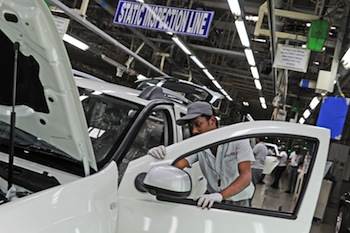
Some of the investments have also been for exports; the increasing Indian content of vehicles manufactured in the US or Europe is a recent phenomenon. This has also led to a number of Indian companies expanding overseas through acquisitions; companies like Amtek in castings and Sumavardhana Motherson (SMIL) in lighting and wiring harnesses have made more progress beyond India than have the OEMs.
In India itself, SMIL has just started a joint venture with Magneti Marelli to make shock absorbers in Pune at an existing Magneti Marelli factory. There is a similar partnership between Setco of India and Spanish company Lignotes Especiales to produce machined ferrous castings in India to supply both vehicle companies and tier ones including Valeo and TRW.
However, it is the expansion of vehicle plants in the country which will have the greatest impact in terms of expanding component production in India. As noted earlier, Ford has persuaded more than 15 of its key suppliers to establish facilities close to its new plant at Sanand, Gujarat, amounting to a total investment of over $80m; a regional government spokesman described this as the largest combined move by the supplier sector into the state since various suppliers to Tata moved from Singur in West Bengal to Sanand a decade ago. By July, 13 suppliers had already moved in, including Getrag Transmissions, Valeo, Noble Automotive, Caparo, Magna Cosma, Indica Industries, Mahabal Metals and JBM Autosystem. Mitsubishi Steel has established a plant to supply Ford outside the supplier park and many more are expected to do the same in the near future.


































